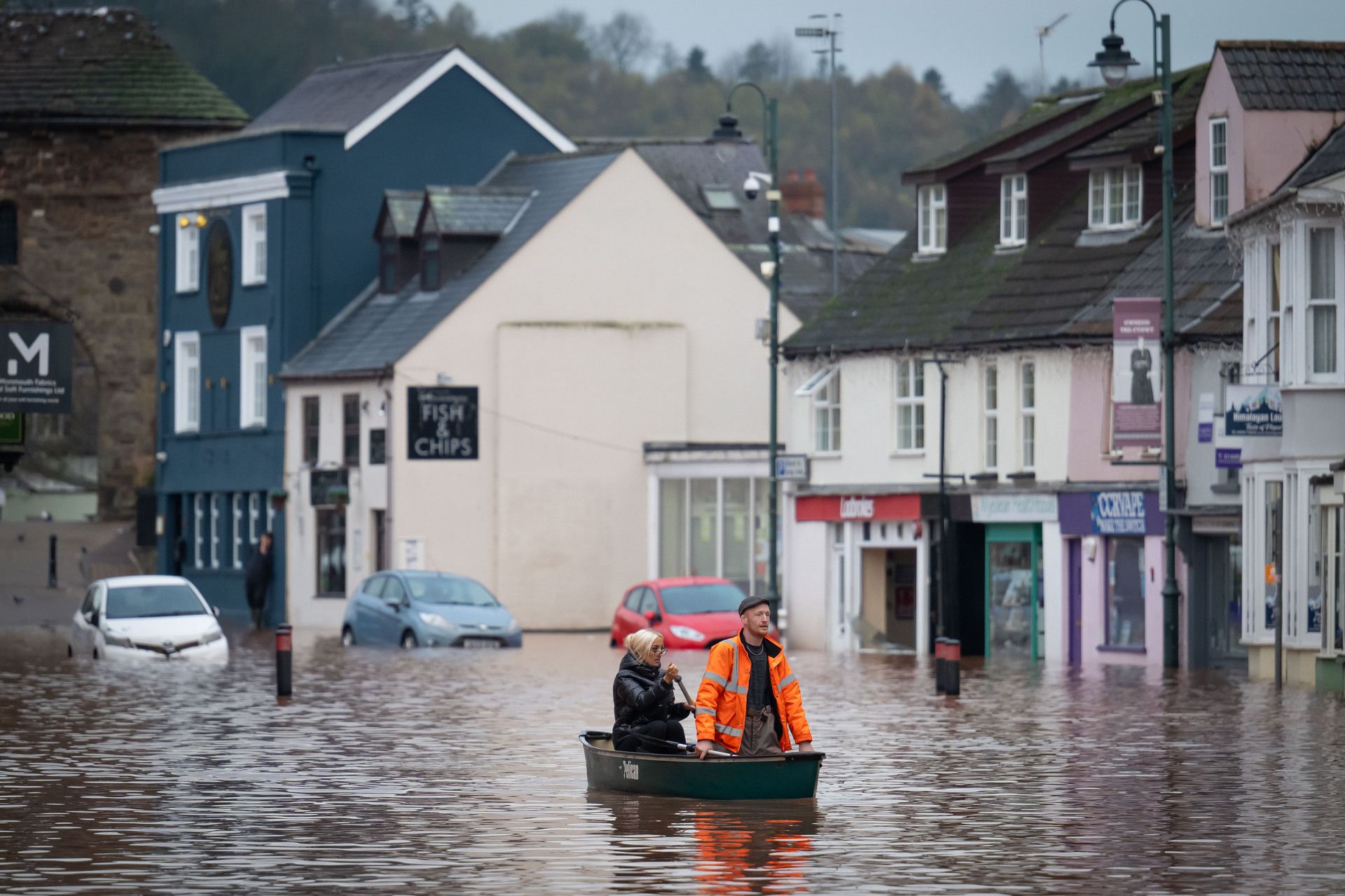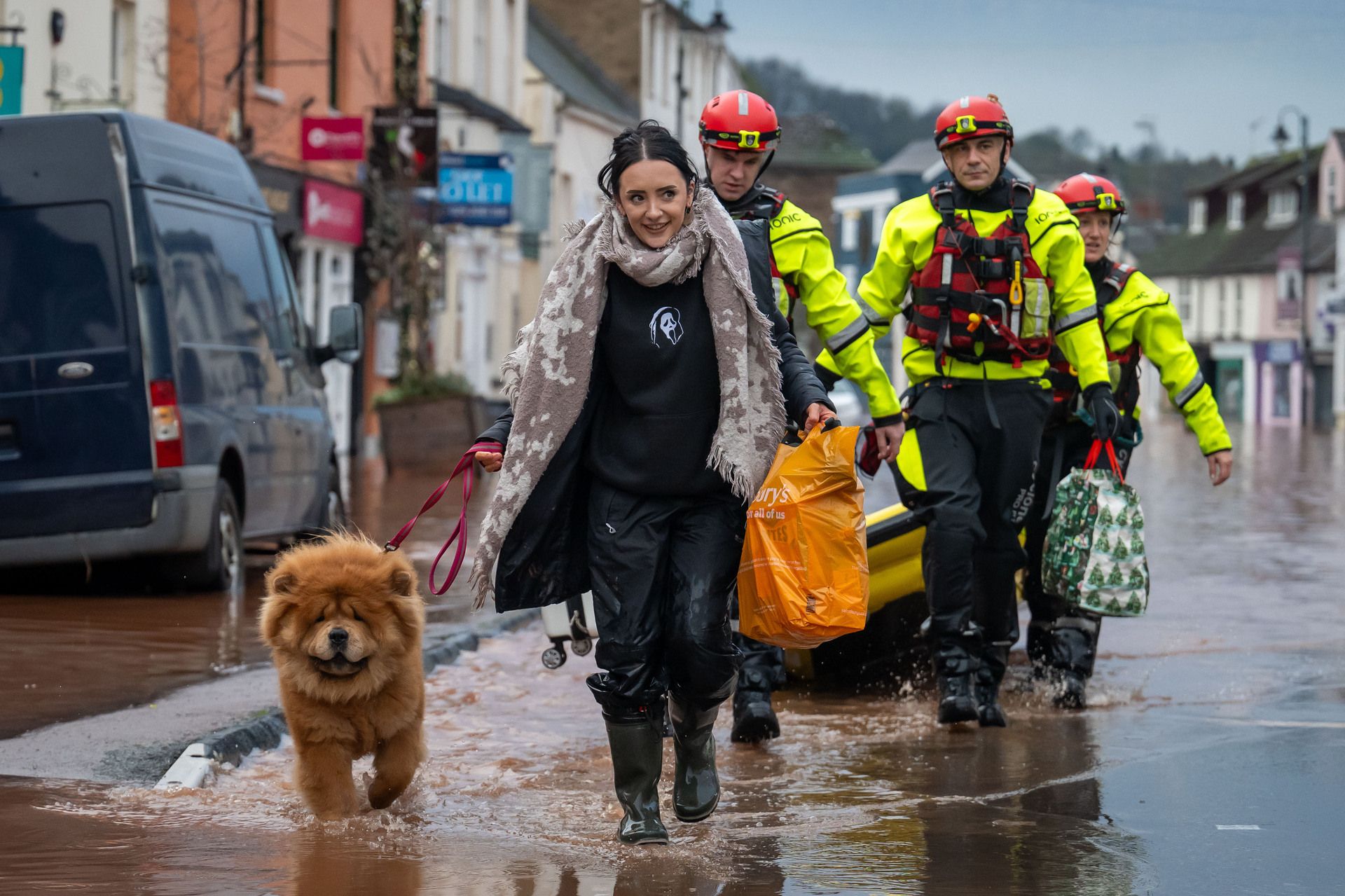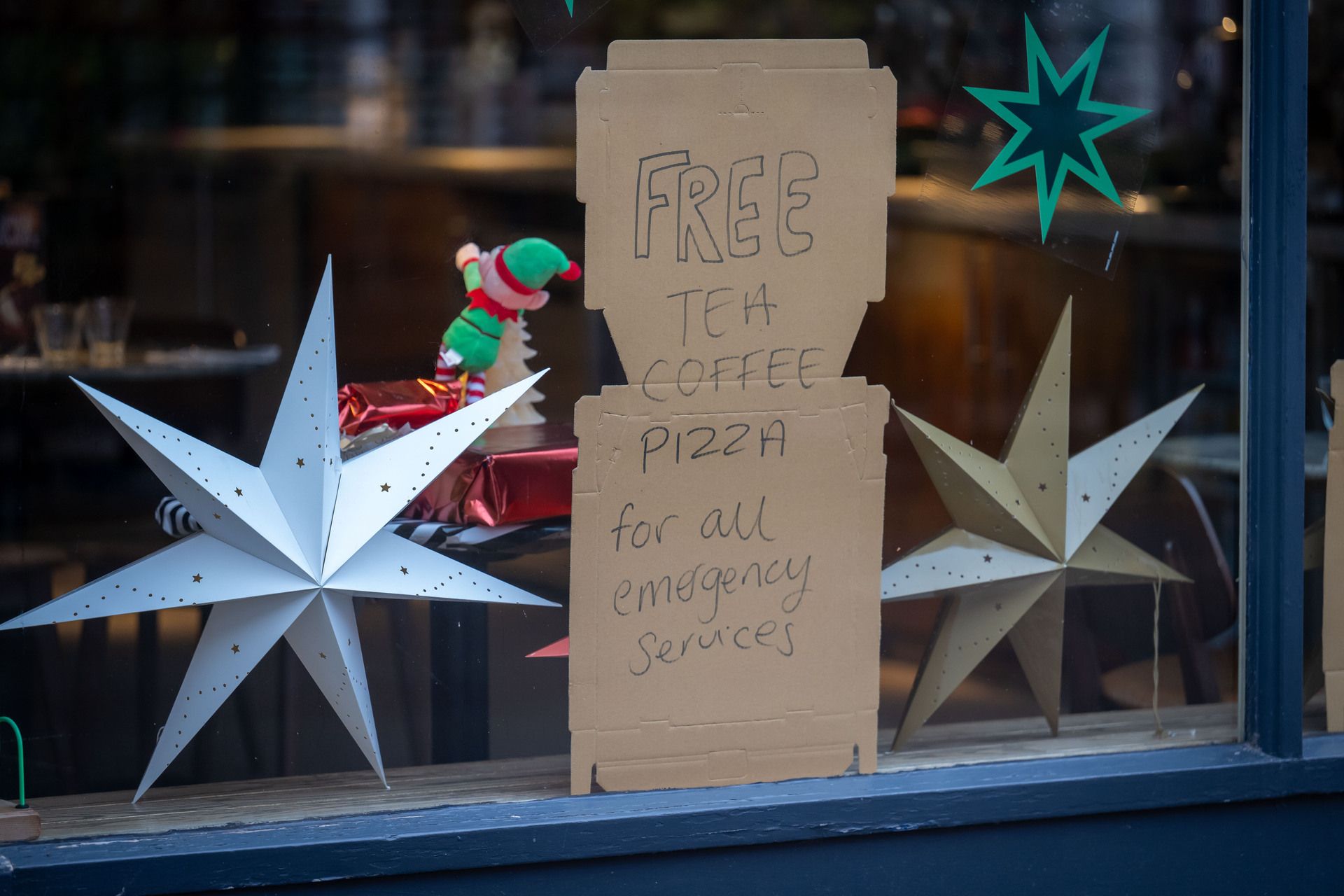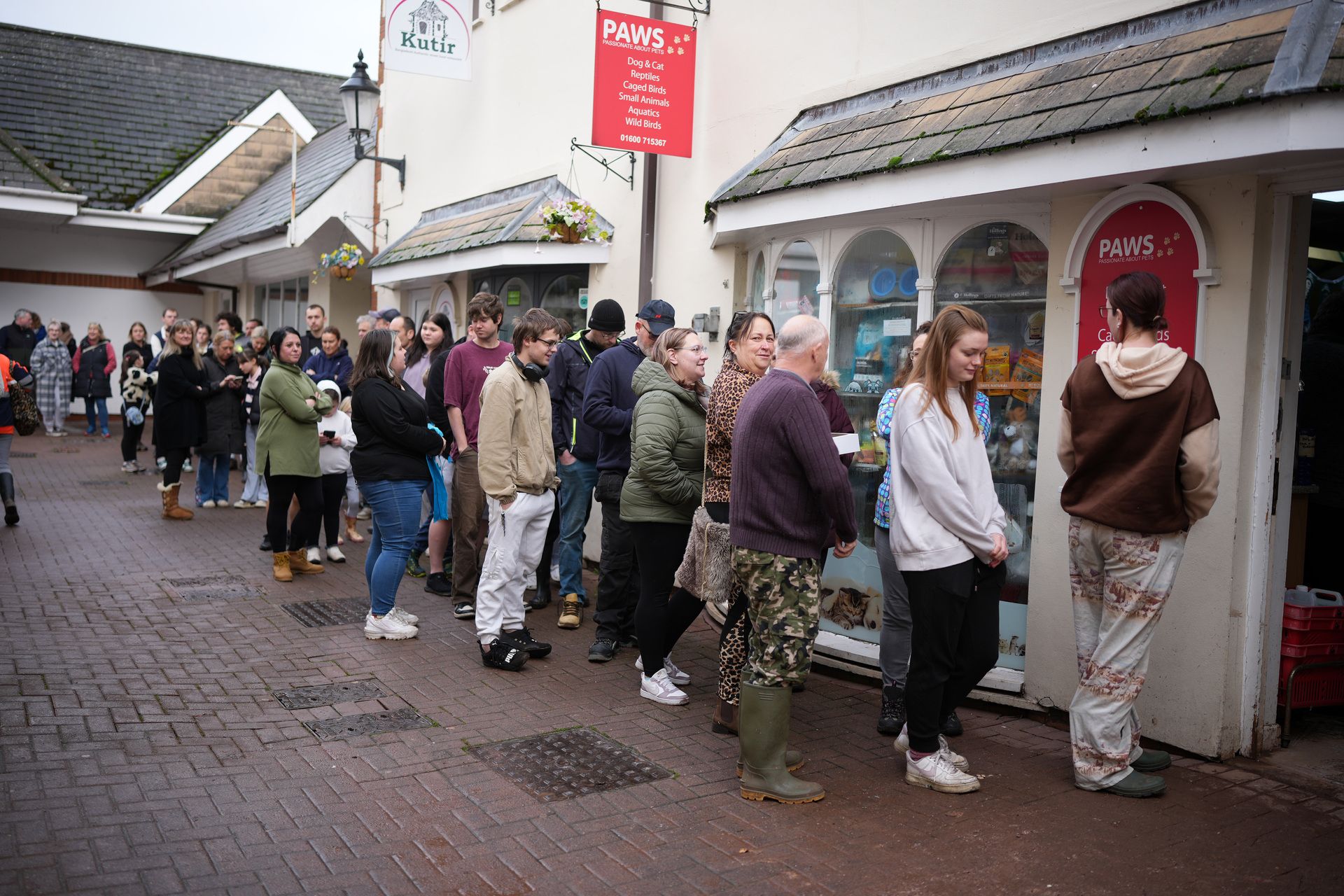
Monnow Street in Monmouth, Wales on 15 November. Photo: Matthew Horwood/Getty
On Monday, a friend in London sent me a video showing a Waitrose supermarket with brown floodwater, swirling like the sea, halfway up its front doors. Two other old colleagues texted later, having seen similar footage, realised it was from Monmouth two days ago, “and were we doing OK?” None of them had read any news about it. But in Monmouthshire, where I live, Storm Claudia was unmissable.
Last Friday in our house on a hill, the rain was hammering so hard that I kept wondering what would come next. Eight miles north-west, the Tafalog rain gauge registered nearly 120mm – five inches – of rain in 12 hours. The story about the River Monnow overtopping flood defences and swamping a market town of 10,500 people, as well as many surrounding villages, was covered well on TV, but barely mentioned in several national newspapers (in the Guardian, at 5.30pm on Saturday, when people were still being rescued, the headline read: “Storm Claudia: Arctic winds to bring snow and -7C temperatures”).
And while flood management is devolved to the Welsh government, I expected the prime minister to say something meaningful. He had time to announce new immigration plans and congratulate the Scottish football team. But a direct statement of sympathy and support for Monmouthshire never came.
The Range Rover became buoyant: the rescue commander remembers seeing it ‘take off at speed’, then disappear with five passengers inside, completely submerged
This feels partly like a sidelining of Wales in the national agenda, but also something more than that: a kind of disaster ennui. Floods aren’t new any more. They have become commonplace: but the way they are disregarded by some of the media and the government is deeply dangerous. How news reaches us has also changed radically in recent years, which makes things worse: algorithms have become so personalised that only the most shocking footage, as in Monmouth’s case, eventually gets through.
There were also floods in Abergavenny, and remote villages such as Skenfrith, which has experienced four in the last five years. When the raging floodwaters dry out, they leave lasting physical, financial and emotional damage. This is exacerbated now, I discover, by the ongoing cost of living crisis, the after-effects of austerity on local government funding, and the escalating race against climate change.

This week in Monnow Street in Monmouth, Wales. Photo by Matthew Horwood/Getty
It’s an icy, bright Thursday morning in Monmouth, the river four and a half metres lower than where it was on Saturday morning. The council has set up a humanitarian centre in the town’s Shire Hall, offering advice, support, donations, warmth and tea, and further down Monnow Street (the town’s high street, and site of the swirling-river video), Rentokil vans and skips line the pavements.
In a body-warmer and beanie hat, Catherine Hall is at the till in one of the four branches of the independent Salt and Pepper chain, which sells gifts, toys, clothes and cookware, set up by her mother, Brenda. Two of the shops, sitting just as the road rises uphill, are operational; the other two are now empty, finally cleared of water, mud and silt.
“Then there’s our storerooms in the cellar,” she adds; she currently doesn’t know what stock she has, “because we're trying to get an understanding of what’s damaged and what's not”. She’s also trying to find out how to make the properties safe and look after her team. What’s her biggest concern now? “Getting the positive message out there that Monmouth is open. The large shops might not be open yet, but the independents are.” How? “We’re resourceful. We have to be.”
On Wednesday, the Welsh government announced £2.5m in flood funding for Monmouthshire, including grants to local households. Apart from “discretionary” business rate relief, no other business support has been announced at the time of writing.

A shop in Monnow Street offers refreshments to the Emergency Services. Photo: Matthew Horwood/Getty
Further up the Monnow, in the hilly village of Grosmont, is Doris Pears, 94, who was evacuated on Saturday afternoon from her home in Monmouth’s Chippenham Court, a development of independent flats for the over-60s. She woke up to muddy water trickling, then pouring, through the air bricks in her walls. “I had my wellies on, but my feet still got wet,” she says.
Built in the 1980s, these flats had never come close to flooding before; the Monnow reached a record high of 6.658 metres in Monmouth at 2.45am on Saturday. The residents, most over 80, headed to the first-floor flats for safety; they heard today that the repairs will take six months, Doris’s daughter, Diane, says. Doris is resilient – she was “a child in London during the Blitz”, she tells me – but she says she’ll miss her neighbours and her table tennis classes. “And it’s my home, isn’t it?”
A few roads away from Doris, Chloe Skinner, landlady of the Angel Inn, is still getting over her “craziest Friday in years” (full disclosure: the Angel is my local, and I saw the story that follows unfurl on a WhatsApp group). On Friday afternoon, Skinner posted on social media for locals to “hunker down with us, if you can make it to us safely”; then a few hours later she warned people “not to travel … Grosmont is an island”. Her next post requested help accommodating stranded people, including some who had been rescued from the roof of a submerged Range Rover a mile away at Little Mill Bridge, one of two nearby river crossings at the border between England and Wales.
Doris, 94, woke up to muddy water trickling, then pouring, through the air bricks in her walls: ‘I had my wellies on, but my feet still got wet’
The morning after, both bridges to England were badly damaged and closed, and Skinner started writing letters to local and national politicians – “out of anger,” she says. Little Mill Bridge had been damaged twice before, in 2021 and 2024, and, despite local pressure, hadn’t been repaired; the closure now meant a vital route for locals, students, businesses and their staff, in an already remote community, was gone.
The other main road bridge, connecting Abergavenny and Hereford, is also closing for three nights in December. “That’s our Christmas trade,” Chloe says. “And what if an ambulance needs to get through on those nights, and someone dies?”
This Christmas, she says, “and I’m being candid now, is make or break for our pub. The rates for everything are mad. And this adds to the pressure of it, which is already something that's really emotional, because this isn’t just a job: it's our livelihood, it's our community.”
As I’m finishing this article, I speak to two people who have experienced natural disasters firsthand. The first is Mary Ann Brocklesby, leader of Monmouthshire council, who worked in international development before leading teams in these flood response efforts. She’s been present in flooding in Pakistan, earthquakes and tsunamis in Indonesia, and drought in Ethiopia. “We need to see this flooding as our new normal, and not as singular events,” she says. “We need to start – as a nation, not just as a county – thinking through how we deal with extreme weather events. Our teams have been magnificent, but we can't keep doing it every three months.”

Locals queuing outside a Monmouth pet shop volunteering to look after fish following a social media appeal that electricity would be cut off to aquariums. Photo: Christopher Furlong/Getty
Then I get a call from Nick Crum, water rescue team commander at Hereford and Worcester Fire Service, who led the Range Rover rescue operation on Friday evening. He talks me calmly through the situation in horrifying detail: the blue-light journey to get there; the “30-45 minutes” trying to reach the vehicle by boat in fast-flowing, rising water; the three-ton silage bales and LPG tanks rocketing down the river; all of it happening in “pitch darkness”. The Range Rover then became buoyant: Crum remembers seeing it “take off at speed”, then disappear with five passengers inside, completely submerged.
Then he heard a crunch: the car had, by chance, got stuck in a tree, and the passengers “somehow” managed to climb out of the windows. How did it feel when they finally reached relatively dry land? “It felt quite euphoric, if I’m honest.” He is keen to praise Darryl in his team: “He was on the phone to the people in the car for the majority of the incident and when the car floated away….his calmness and professionalism ensured that the casualties remained calm.” After dropping the passengers off in the safety of the pub, Crum spent the rest of the night rescuing people from their homes in Monmouth, before finally getting home at 11.30 on Saturday morning. “It felt unique and unprecedented,” he says of the night. “I hope that it was.”
Jude Rogers is an arts and culture writer/broadcaster who lives in Monmouthshire